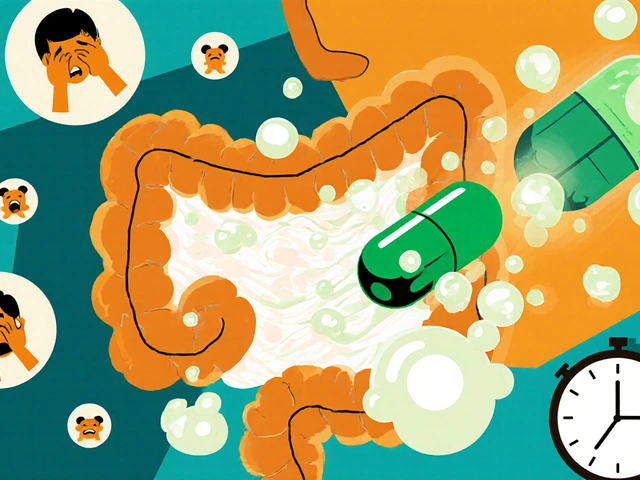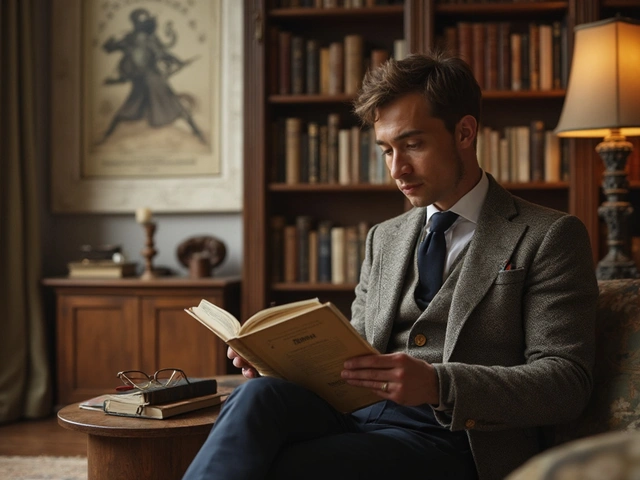If you’ve been hunting for a pill that can help control blood sugar without needles, you’ve probably bumped into Rybelsus. It’s the first oral GLP‑1 medication approved for type 2 diabetes, and it’s shaking up the way doctors approach treatment. In the next few minutes you’ll get the facts you need to decide if it’s right for you, how to take it safely, and what to expect once you start.
- Rybelsus is an oral form of semaglutide, a GLP‑1 receptor agonist.
- It lowers A1C by about 1‑1.5% and can help with weight loss.
- Typical starting dose is 3mg daily for 30days, then up‑titrated to 7mg or 14mg.
- Common side‑effects include nausea, vomiting, and mild diarrhoea; serious risks are rare.
- Not for people with personal or family history of medullary thyroid carcinoma or multiple endocrine neoplasia type 2.
What is Rybelsus and How It Works?
Rybelsus contains the active ingredient semaglutide, which mimics the action of the gut hormone GLP‑1. After you eat, GLP‑1 tells the pancreas to release insulin, slows down the emptying of the stomach, and reduces appetite. By activating the same receptor, semaglutide helps keep blood glucose in check, even after a high‑carb meal.
What makes Rybelsus unique is the technology that protects the molecule from stomach acid. A tiny amount of an absorption enhancer called SNAC (sodium N‑(8‑[2‑hydroxybenzoyl]amino) caprylate) is combined with the drug, allowing a small fraction to slip through the stomach wall and into the bloodstream. The result is a once‑daily tablet that works just like the injectable versions of GLP‑1 drugs.
Clinical trials (the PIONEER series) showed that Rybelsus lowers glycated haemoglobin (A1C) by an average of 1.0‑1.5% over 26weeks, and many participants lost 4‑6% of their body weight. Those numbers are on par with the injectable semaglutide (Ozempic) but without the needle.
Who Should Consider Rybelsus - Eligibility, Contra‑indications & Who to Avoid
Rybelsus is approved for adults with type 2 diabetes when diet and exercise alone aren’t enough. It can be used as a first‑line injectable‑alternative or added to metformin, sulfonylureas, SGLT‑2 inhibitors, or insulin.
Before starting, your doctor will check a few things:
- Kidney function - the drug isn’t cleared by the kidneys, but severe renal impairment may still need caution.
- Thyroid health - anyone with a personal or family history of medullary thyroid carcinoma (MTC) or multiple endocrine neoplasia type 2 (MEN2) should stay away. The FDA label includes a black‑box warning for this.
- Pregnancy & breastfeeding - safety isn’t established, so it’s generally avoided unless the benefits clearly outweigh the risks.
- Gastro‑intestinal disorders - conditions that slow stomach emptying (gastroparesis) may worsen symptoms.
People who are already on other GLP‑1 agonists can usually switch, but a 30‑day wash‑out period is recommended to avoid overlapping effects. If you’re on a sulfonylurea, your doctor may reduce that dose to lower the risk of hypoglycaemia once the GLP‑1 drug kicks in.

Practical Guide: Dosing, Administration, Side‑Effects & Monitoring
Here’s the step‑by‑step plan most clinicians follow:
- Start low: 3mg tablet taken on an empty stomach with up to 120ml of plain water. Wait at least 30minutes before eating, drinking anything other than water, or taking other oral meds.
- Stay consistent: Take it at the same time each day - usually first thing in the morning.
- Watch for nausea: The most common early side‑effect. Eating a light, bland meal the day after starting can help.
- 30‑day check: If A1C hasn’t dropped by at least 0.5% and you tolerate the drug well, increase to 7mg daily. If you need stronger control, move to 14mg after another 30days.
- Monitor: Schedule a follow‑up visit at 12 weeks to review A1C, weight, and any adverse events. Blood tests for thyroid function are optional unless you have risk factors.
Typical side‑effects (usually mild and transient):
- Nausea - most people feel it in the first week.
- Vomiting or occasional diarrhoea.
- Decreased appetite - can lead to useful weight loss, but watch for signs of excessive calorie restriction.
- Headache or fatigue - often resolve as the body adapts.
Rare but serious reactions to keep an eye on:
- Pancreatitis - persistent, severe abdominal pain that radiates to the back.
- Severe allergic reaction - swelling of the face, lips, or throat.
- Signs of thyroid tumour - a lump in the neck or persistent hoarseness.
If any of these appear, call your healthcare provider immediately.
Frequently Asked Questions & Next Steps
Q: Can I take Rybelsus with other diabetes pills?
Yes, many patients stay on metformin while adding Rybelsus. If you’re on sulfonylureas or insulin, your doctor will likely lower those doses to avoid low blood sugar.
Q: How fast will I see results?
Blood‑sugar reductions start within 2‑4weeks, but the full A1C benefit shows after about 12weeks. Weight loss is gradual - about 2‑4kg over 6 months on the 14mg dose.
Q: Do I need to store the tablets specially?
Keep them below 30°C (86°F) and away from moisture. A kitchen cabinet is fine; avoid the bathroom where humidity spikes.
Q: What if I miss a dose?
Take the missed tablet as soon as you remember, provided it’s still within the next 12hours. If it’s later, skip it and resume your regular schedule - don’t double up.
Q: Is Rybelsus covered by NHS prescriptions?
Yes, it’s listed on the NHS formulary for type 2 diabetes, but you’ll need a prescription from a GP or specialist. Some private insurers also cover it, though prior authorisation may be required.
If you think Rybelsus could fit into your diabetes plan, the next move is simple: book an appointment with your GP or an endocrine specialist. Bring a list of your current meds, recent blood‑sugar logs, and any concerns about thyroid history. They’ll run a quick lab work‑up, confirm eligibility, and set you on the starter dose.
Remember, medication is only one piece of the puzzle. Pairing Rybelsus with a balanced diet, regular walking, and routine monitoring maximises the chance of keeping A1C below 7% and shedding a few pounds along the way.









Stephanie S September 20, 2025
Rybelsus, being the first oral GLP‑1 agonist, represents a fascinating advance in diabetes care; it offers a needle‑free alternative, which many patients truly appreciate. The drug’s mechanism-mimicking the gut hormone GLP‑1-helps regulate insulin release, slow gastric emptying, and curb appetite, thereby supporting both glycaemic control and modest weight loss. Clinical data suggest an A1C reduction of roughly 1‑1.5% over 26 weeks, comparable to injectable semaglutide, but without the inconvenience of daily injections. Starting doses are modest, typically 3 mg daily for the first month, then titrated upward to 7 mg or even 14 mg based on tolerance and therapeutic response. Common side‑effects, such as nausea, vomiting, and mild diarrhoea, usually subside within a few weeks; patients should be counseled to take the tablet with a small amount of water on an empty stomach and wait at least 30 minutes before eating or drinking anything else. Contra‑indications are crucial to note: individuals with a personal or family history of medullary thyroid carcinoma or MEN 2 should avoid Rybelsus due to a black‑box warning. Renal function does not heavily influence drug clearance, yet severe impairment warrants caution. Patients who are pregnant, breastfeeding, or have significant gastrointestinal disorders should discuss alternatives with their healthcare provider. The tablet requires standard storage-below 30 °C and away from moisture-making it convenient for most households. Insurance coverage, such as via the NHS, is generally available, though prior authorisation may be required by some private insurers. Ultimately, Rybelsus should be viewed as one component of a comprehensive diabetes management plan that includes diet, exercise, and regular monitoring.
Bradley Fenton September 21, 2025
Sounds solid, just start low and watch the stomach.
Gary Levy September 22, 2025
I’ve been on Rybelsus for a few months now, and the gradual weight drop was a pleasant surprise. The tablet’s once‑daily routine fits nicely into my morning ritual, and I’ve noticed fewer spikes after-carb meals. My A1C slid from 8.2 % to 7.0 % after the first three months, which aligns with the trial data. I did experience some nausea initially, but a bland diet and staying hydrated helped. If you’re comfortable with the occasional upset stomach, it’s definitely worth a try, especially if you dislike needles.
sourabh kumar September 23, 2025
Just remember to check thyroid labs if you have any risk.
Christian Miller September 23, 2025
While the pharmaceutical industry promotes Rybelsus as a breakthrough, one must consider the hidden agendas behind its marketing. Large corporations often push new drugs to increase profits, sometimes overlooking long‑term safety data. Keep an eye on independent studies and discuss any concerns with a physician who isn’t tied to a drug rep.
NORMAND TRUDEL-HACHÉ September 24, 2025
Honestly, if you’re chasing the latest fad, there are cheaper, proven options out there. Semaglutide’s oral form is pricey, and the marginal weight loss isn’t worth the hype for most.
AJIT SHARMA September 25, 2025
Rybelsus? A glorified pill that pretends to be a miracle. The side‑effects can be brutal, and the “convenient” marketing is just a ploy to get patients hooked on brand‑name meds. Look deeper before swallowing the hype.
Neber Laura September 25, 2025
Don’t be fooled, it’s just another drug.
Karen Nirupa September 26, 2025
From a cultural perspective, the shift toward oral GLP‑1 agents represents a significant evolution in diabetes management. It respects patient preferences for non‑invasive therapies while maintaining clinical efficacy. Moreover, the integration of such medications into standard practice may reduce stigma associated with injectable treatments, fostering broader acceptance across diverse populations.
Quinn Comprosky September 27, 2025
Exactly – the convenience factor can’t be overstated; many patients struggle with injection anxiety, and an oral option removes that barrier. That said, adherence still hinges on consistent daily intake, especially taking it on an empty stomach with limited water. If you forget a dose, it’s better to skip rather than double up, which can exacerbate nausea. Monitoring A1C every 12 weeks remains essential to gauge effectiveness, and adjusting the dose based on tolerance is key. Also, keep in mind the potential for pancreatic issues, though rare, and report any persistent abdominal pain to your provider immediately.
Thomas Ruzzano September 27, 2025
Yo, Rybelsus is dope for those who hate needles but still want that GLP‑1 glow. Just watch the tummy vibes.
Dan Tenaguillo Gil September 28, 2025
When considering Rybelsus, it is helpful to adopt a holistic view that incorporates both medical evidence and patient lifestyle. The pharmacokinetics of semaglutide, enhanced by the SNAC absorption enhancer, allow for sufficient bioavailability despite oral administration. Nonetheless, clinicians should assess renal function, thyroid history, and gastrointestinal health before prescribing. Patients should be educated on the proper administration technique: an empty stomach, 120 ml of water, and a 30‑minute waiting period before any food or other meds. This protocol maximises absorption and mitigates gastrointestinal upset. Regular follow‑ups at 12‑week intervals enable timely adjustments of dose and monitoring for rare adverse events such as pancreatitis or thyroid neoplasia. Additionally, insurance coverage and cost considerations differ by region; verifying formulary status can prevent unexpected out‑of‑pocket expenses. By integrating these practical steps with a balanced diet and regular physical activity, the therapeutic benefits of Rybelsus can be fully realized.
Tiffany Owen-Ray September 29, 2025
Building on the inclusive mentor’s points, I would emphasize the psychological aspect of transitioning to a new medication. Patients often experience anxiety about side‑effects, especially nausea, which can lead to early discontinuation. It helps to set realistic expectations: nausea typically peaks within the first week and subsides with continued use. Encouraging patients to keep a symptom diary can provide valuable feedback for clinicians to fine‑tune dosing. Moreover, peer support groups-whether online or in‑person-offer shared experiences that normalize challenges and foster adherence. Including family members in education sessions ensures a supportive home environment, which has been shown to improve glycemic outcomes. Lastly, remind patients that lifestyle modifications remain the cornerstone of diabetes management; medication enhances, but does not replace, a balanced diet and regular exercise.
Jill Brock September 29, 2025
Honestly, the drama around Rybelsus is overblown; it’s just another pill and you’re better off focusing on real food, not gimmicks. Stop acting like this is some miracle cure.
Ellie Chung September 30, 2025
Rybelsus is a game‑changer, folks! The convenience of a daily tablet beats the hassle of needles any day.
Sophia Simone October 1, 2025
While many celebrate the oral formulation, one might question whether the pharmacodynamic profile truly matches that of its injectable counterpart; the literature remains equivocal, and independent verification is prudent.
Juan Sarmiento October 2, 2025
Hey team, just wanted to say if you decide to try Rybelsus, pair it with a solid walking routine – the combo can really boost your results!
Patrick McVicker October 2, 2025
Nice summary! 👍 I’ve heard mixed reviews, but the convenience factor is huge.
Liliana Phera October 3, 2025
Convenience aside, we must critically assess the cost‑benefit ratio – is a pricey pill truly better than lifestyle changes? The data isn’t always crystal clear.
Dean Briggs October 4, 2025
Throughout my years working with patients, I’ve observed that the success of any diabetes therapy hinges on individualized care. Rybelsus adds a valuable tool, especially for those hesitant about injections. However, it should never replace comprehensive education on nutrition, physical activity, and self‑monitoring. By integrating this oral GLP‑1 agent with a personalized plan, patients can achieve meaningful glycemic control while maintaining quality of life.